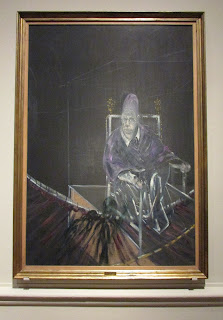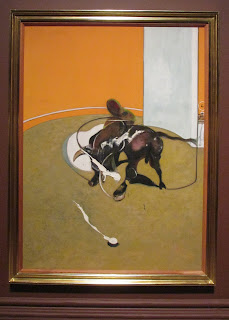Second Version Triptych 1944, 1988 (detail)
"We are meat, we are all potential carcasses" - Francis Bacon
John Deakin, Photograph of Francis Bacon in Front of a Door, c. 1967
To the RA for this much anticipated retrospective dealing with the representation of animals and the animalistic in relation to the human body in Bacon's oeuvre. The exhibition charts the development of Bacon's work, unfolding chronologically across the RA's main galleries, opening dramatically with Head I, given a whole gallery space to itself, and continues to his final painting Study of a Bull in the last room of the exhibition. Bacon
was a self-taught painter and you can certainly see limitations in
his work. The failings in his draughtsmanship are particularly evident in
some paintings, but he manages to cover this up in later paintings with
the development of his own powerful visual language and idiosyncratic style of
painting. The animalistic has perhaps always seemed to be an important part of Bacon's oeuvre, whether it be straighforward depictions of animals and the big game that he observed first-hand on visits to Africa, or the snarling, primal screams of his series of Popes. Mouths, open, baring fangs, threatening to bite, in all of their savagery are one of the most distinguishing features here of Bacon's work serving to underscore the theme and links between animals and the human figure. Bacon also took inspiration from the groundbreaking photographs of Eadweard Muybridge which accurately document animal and human locomotion. One of the most shocking paintings in the exhibition for me was Paralytic Child Walking on all Fours, which again like the snarling mouths captured in other works harks back to something primal in mans evolution. It is so beautifully painted, but hard to look at for too long as it is genuinely disturbing. Animalistic impulses were also famously played out in Bacon's private life where he engaged in sadomasochistic relationships with his various lovers. One, Peter Lacy was particularly brutal, and was reported to want Bacon 'chained to a wall like an animal, sleeping and shitting on a bed of straw'. This equation of sex with violence is best seen in the room in the exhibition here containing the Bullfight series. Here we see the ritualistic, potentially fatal dance in which matadors fuse with the muscular brawn of the bulls. The surfaces of these paintings are streaked with the ejaculations of white paint. 'Bullfighting is like boxing - a marvellous aperitif to sex', Bacon is reported to have observed. This is a really powerful survey which confirms Bacon's contribution to the development of 20th C. art, and just why Bacon is one of the most important painters of the last century.
Head I, 1948
Triptych - Studies of the Human Body, 1970 (detail)
Triptych - Studies of the Human Body, 1970 (detail)
Henrietta Moraes, 1966
Study for Bullfight No. 1, 1969 (detail)
Study for Bullfight No. 1, 1969
Study for Bullfight No. 2, 1969
Study of a Bull, 1991
Francis Bacon: Man and Beast
until 17th April
Royal Academy of Arts
Burlington House
Piccadilly
London






































No comments:
Post a Comment